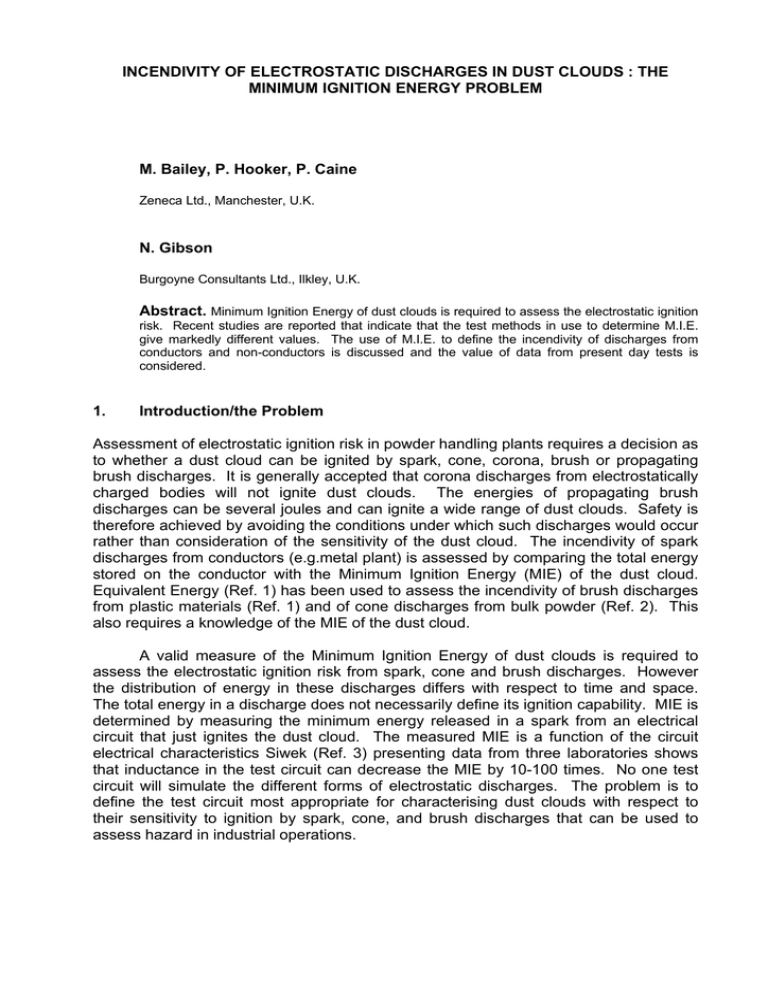Incendivity of Electrostatic Discharges in Dust Clouds
advertisement

INCENDIVITY OF ELECTROSTATIC DISCHARGES IN DUST CLOUDS : THE MINIMUM IGNITION ENERGY PROBLEM M. Bailey, P. Hooker, P. Caine Zeneca Ltd., Manchester, U.K. N. Gibson Burgoyne Consultants Ltd., Ilkley, U.K. Abstract. Minimum Ignition Energy of dust clouds is required to assess the electrostatic ignition risk. Recent studies are reported that indicate that the test methods in use to determine M.I.E. give markedly different values. The use of M.I.E. to define the incendivity of discharges from conductors and non-conductors is discussed and the value of data from present day tests is considered. 1. Introduction/the Problem Assessment of electrostatic ignition risk in powder handling plants requires a decision as to whether a dust cloud can be ignited by spark, cone, corona, brush or propagating brush discharges. It is generally accepted that corona discharges from electrostatically charged bodies will not ignite dust clouds. The energies of propagating brush discharges can be several joules and can ignite a wide range of dust clouds. Safety is therefore achieved by avoiding the conditions under which such discharges would occur rather than consideration of the sensitivity of the dust cloud. The incendivity of spark discharges from conductors (e.g.metal plant) is assessed by comparing the total energy stored on the conductor with the Minimum Ignition Energy (MIE) of the dust cloud. Equivalent Energy (Ref. 1) has been used to assess the incendivity of brush discharges from plastic materials (Ref. 1) and of cone discharges from bulk powder (Ref. 2). This also requires a knowledge of the MIE of the dust cloud. A valid measure of the Minimum Ignition Energy of dust clouds is required to assess the electrostatic ignition risk from spark, cone and brush discharges. However the distribution of energy in these discharges differs with respect to time and space. The total energy in a discharge does not necessarily define its ignition capability. MIE is determined by measuring the minimum energy released in a spark from an electrical circuit that just ignites the dust cloud. The measured MIE is a function of the circuit electrical characteristics Siwek (Ref. 3) presenting data from three laboratories shows that inductance in the test circuit can decrease the MIE by 10-100 times. No one test circuit will simulate the different forms of electrostatic discharges. The problem is to define the test circuit most appropriate for characterising dust clouds with respect to their sensitivity to ignition by spark, cone, and brush discharges that can be used to assess hazard in industrial operations. 2. Sensitivity to Ignition by Spark Discharges Spark discharges occur when static electricity accumulates on, and is released from, metal plant. The electrical characteristics of the test circuit should replicate those of unearthed metal plant. Tests on a wide range of equipment in chemical plants (e.g. reactor, silo, pipework, tools, shovel valves, gas cylinder etc) show that the resistance is a few ohms and that with one exception the inductance is less than 3 lH. The exception was the internal metal coil in a flexible rubber connection (L = 220 lH). This indicates that the M.I.E. test circuit should be essentially capacitative. The measured MIE value depends not only upon the electrical characteristics of the test circuit but also on the geometry of the electrode gap, electrode size/shape and the discharge triggering mechanism. Data obtained by 12 test houses for 9 different powders is summarised in Table 1. This indicates MIE data is very dependent on test conditions. In industrial situations the “gap” across which a spark could occur cannot be controlled and it must be assumed that the discharge conditions producing maximum incendivity for a given energy value could be present. The test method used to assess electrostatic hazard from conductors should therefore be based on a capacitative discharge with an electrode configuration etc. that produces the lowest value of MIE. Two types of equipment that are based on capacitative circuitry are in common use. (a) Equipment based on BS 5958 (Ref. 4): sparks are released from the high voltage electrode (10-30kV) across a spark gap of not less than 2mm. The voltage is slowly increased until a discharge is produced and the energy in the spark is considered to be that on the capacitative circuit. Typical values of inductance is 12 lH. (b) Kuhner Mike 3 equipment : this meets the draft European requirements (Ref. 5). It differs from the BS 5958 equipment in that the electrode is more pointed. The electrode gap is 6mm. A moving electrode system is used to trigger the sparks of 10mJ and above. For 1mJ and 3mJ sparks a high voltage relay is used to trigger the discharge at 15kV. The inductance can be 20 lH or 1020 lH. The former is used in hazard assessments. MIE data obtained for 17 powders with the two test methods in no case did the BS 5958 test produce the lower MIE. With 4 powders the tests were in agreement. The Mike 3 test produced the lower MIE values with 13 powders. Most important the BS 5958 test failed to detect sensitive materials (i.e. MIE < 10mJ) in 6 cases. It has been reported (Ref. 6) that when one powder was tested in 17 test houses using MIKE-3 equipment, 16 obtained the value 1 – 3 mJ and 1 the value < 1 mJ. This is good reproducibility. It is concluded that the MIKE 3 equipment can provide data that can be reasonably used to assess the incendivity of sparks from insulated conductors. Although the test in BS 5958 is based on capacitative circuit its electrode configuration etc is not such as to produce the minimum value of M.I.E. from such a circuit. 3. Sensitivity To Ignition By Brush and Cone Discharges The characteristics of brush and cone discharges differ markedly in terms of the temporal and spatial distribution of energy from spark discharges. Comparison of the total energy in this type of discharge with the MIE determined using a capacitative spark circuit does not provide a measure of the incendivity of the discharges. To overcome this problem Gibson and Lloyd (Ref. 1) introduced the concept of Equivalent Energy. This states that if a brush or cone discharge just ignites a flammable atmosphere with an MIE of XmJ then it will not ignite a flammable atmosphere whose MIE exceeds XmJ. At present the MIE value is that determined using a capacitative circuit. The essential pre-condition for the concept of Equivalent Energy to be valid is that the flammable atmospheres used in the ignition tests have similar combustion initiation characteristics to those for which the risk from brush and cone discharges is being assessed. This condition has been shown to be satisfied for common gases and vapours (Ref. 1). The effect of inductance on M.I.E. of dust clouds indicates that different dust clouds may not react in terms of combustion initiation to changes from spark to cone, spark to brush. Glor (Ref. 2) has overcome the problem for cone discharges by directly igniting dust clouds by them. In the case of brush discharges, variations in the M.I.E. over the range 1 – 10 mJ can markedly effect safety measures specified for a process. Three powders with low M.I.E. values have been tested with MIKE 3 apparatus using circuits with inductance of 20 lH and 1020 lH. The results are shown in Table 2. Narrow particle size bands were used to minimise the effect of the different settling times for particles of different sizes. The data indicates that, for dust clouds sensitive to ignition (i.e. M.I.E. < 10mJ), the effect of L may be present for some powders but it is small. It is concluded that the equivalent energy concept can be used to give guidance on the incendivity of brush discharges but that further work is required on this topic to define safe limits. Acknowledgement The authors acknowledge valuable discussions with S. Newton, D.J. Harper, Zeneca Ltd. References (1) (2) (3) (4) (5) (6) N. Gibson and F.C. Lloyd. Br.J. Applied Physics. Vol 16. p.1619 (1965). M. Glor, B. Maurer. J. Electrostatics. Vol. 30. p.123 (1993). R. Siwek, C. Cesana. Process Safety Progress. Vol. 14, No. 2, p.107 (1995). BS 5958. Part 1. British Standards Institution London U.K. (1991). Draft European Standard “Determination of Minimum Ignition Energy of Dust/Air CENTC 305/WG1/SG: 1.2 MIE (April 1998). “Final Report on Calibration Round Robin” Adolf Kuhner AG. Switzerland (1998). Table 1. Data from 12 Test Houses Product Minimum Ignition Energy (mJ) Lowest Highest 59 – 148 1–3 100 – 300 1–3 2145 – 3890 300 – 1000 890 – 8700 100 – 300 > 12500 10 – 100 25 – 125 1–3 148 – 258 1–3 13 – 17 1–3 2500 - 12500 154 - 381 A B C D E F G H I Table 2 : Effect on MIE with changing Particle Size and Inductance Sample A Particle size (lm) L=20lH L=1020l H 150 – 250 Sample B L=20lH L=1020lH > 1000 >1000 Sample C L=20lH L=1020lH >212 3 – 10 3 - 10 150 – 212 1-3 1-3 125 - 150 1-3 1-3 30 - 100 10 – 30 106 – 125 1-3 1-3 30 - 100 30 - 100 10 - 30 3 - 10 75 – 106 1-3 1-3 10 – 30 3 - 10 3 - 10 3 - 10 50 – 75 1-3 1-3 10 - 30 3 - 10 3 - 10 3 - 10 10 - 30 3 - 10 3 - 10 3 - 10 3 - 10 3 - 10 <50 <38


